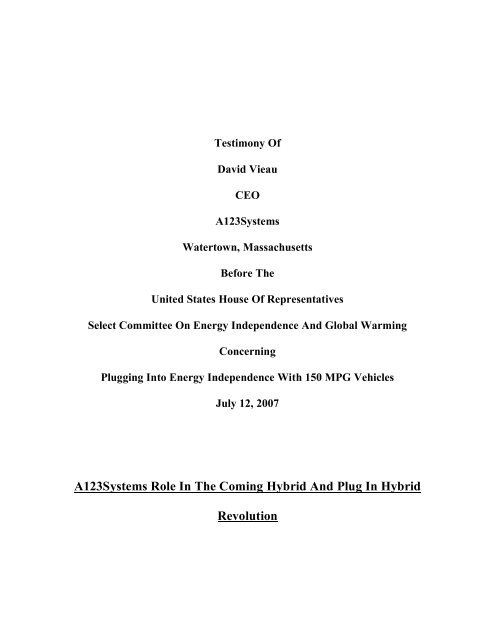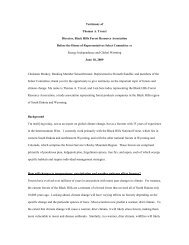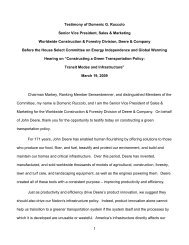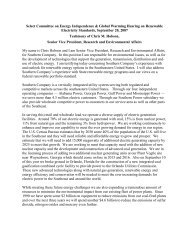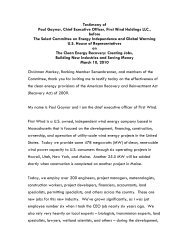David Vieau, President and CEO, A123 Systems - The Select ...
David Vieau, President and CEO, A123 Systems - The Select ...
David Vieau, President and CEO, A123 Systems - The Select ...
You also want an ePaper? Increase the reach of your titles
YUMPU automatically turns print PDFs into web optimized ePapers that Google loves.
Testimony Of<br />
<strong>David</strong> <strong>Vieau</strong><br />
<strong>CEO</strong><br />
<strong>A123</strong><strong>Systems</strong><br />
Watertown, Massachusetts<br />
Before <strong>The</strong><br />
United States House Of Representatives<br />
<strong>Select</strong> Committee On Energy Independence And Global Warming<br />
Concerning<br />
Plugging Into Energy Independence With 150 MPG Vehicles<br />
July 12, 2007<br />
<strong>A123</strong><strong>Systems</strong> Role In <strong>The</strong> Coming Hybrid And Plug In Hybrid<br />
Revolution
<strong>A123</strong>SYSTEMS' ROLE IN THE COMING HYBRID AND<br />
PLUG IN HYBRID REVOLUTION<br />
Mr. Chairman, Congressman Inslee, Congressman Sensenbrenner, <strong>and</strong> other Members of<br />
the Committee,<br />
This Committee's interest <strong>and</strong> efforts in fostering new American technologies in the<br />
critical effort to slow down climate change <strong>and</strong> reduce our dependence on foreign oil is<br />
well known <strong>and</strong> deeply appreciated. I thank you for the opportunity to appear before you<br />
today to explain <strong>and</strong> answer questions about <strong>A123</strong><strong>Systems</strong>' program for developing <strong>and</strong><br />
marketing a state-of-the-art lithium ion battery which we <strong>and</strong> others believe will help<br />
enable this nation to lead a world wide plug-in hybrid transportation revolution, <strong>and</strong> the<br />
importance of a modest transitional tax credit for plug-in hybrid conversion modules so<br />
that revolution can start now.<br />
Let me explain.<br />
<strong>The</strong> Company And Its Products<br />
<strong>A123</strong><strong>Systems</strong> started 5 years ago as an MIT spin off with a $100,000 DOE SBIR grant.<br />
Today it has raised over $100 million, has over 380 employees <strong>and</strong> operates facilities in<br />
Watertown, Massachusetts <strong>and</strong> Ann Arbor, Michigan. We sell millions of batteries<br />
annually to Black <strong>and</strong> Decker, Dewalt <strong>and</strong> others for high powered h<strong>and</strong>held<br />
2
applications. We also are developing higher powered solutions for the aerospace <strong>and</strong><br />
defense industries. T/J Technologies, which is our recently acquired Ann Arbor facility,<br />
is developing batteries for hybrid vehicle applications for the Army. We have been<br />
chosen by GM, <strong>and</strong> other major American <strong>and</strong> European automakers, to help develop <strong>and</strong><br />
power their hybrid <strong>and</strong> plug-in hybrid sedans, SUVs, trucks, buses <strong>and</strong> heavy equipment<br />
moving vehicles which will be coming on line over the next 3 to 5 years.<br />
This has all been made possible by our development of a unique Nanophoshate based<br />
lithium ion battery with a combination of power density, durability <strong>and</strong> safety in excess<br />
of anything mass produced on the market today. This assertion is confirmed by the ever<br />
growing list of American <strong>and</strong> European automakers <strong>and</strong> partners who are choosing<br />
<strong>A123</strong><strong>Systems</strong> as the power source of choice in enabling them to enter the increasingly<br />
attractive <strong>and</strong> profitable hybrid era.<br />
<strong>The</strong> automotive industry is in the middle of a critical transition to electric drive. Fueled<br />
by strong consumer dem<strong>and</strong> for greener vehicles <strong>and</strong> a growing awareness of our greater<br />
responsibilities to our planet <strong>and</strong> our national security, there are now over 65 hybrid<br />
vehicle launches planned by 2010. We will continue to work with all the key players to<br />
optimize our technology <strong>and</strong> provide leading price performance in this market.<br />
<strong>The</strong> next generation of technology beyond the conventional hybrid is the plug-in hybrid.<br />
This significant advance in the technology is one where the US automakers have<br />
established technological leadership <strong>and</strong> which delivers many benefits including<br />
3
government verified 100 MPG or greater efficiencies at a fraction of the cost of gasoline.<br />
<strong>A123</strong><strong>Systems</strong> is a leading supplier of battery technology for hybrids <strong>and</strong> plug-in hybrids.<br />
We are working with General Motors <strong>and</strong> other leading American <strong>and</strong> European<br />
automobile <strong>and</strong> heavy equipment manufacturers to validate <strong>and</strong> introduce this technology<br />
into the market.<br />
Over the years, Congress has been in the forefront of recognizing the need to nurture<br />
these kinds of breakthrough technologies by insuring early stimulation through the wise<br />
use of tax credits to kick start consumer dem<strong>and</strong>. Putting the CLEAR ACT in place in<br />
2005 was critical to both educating the public <strong>and</strong> producing the sales volumes that have<br />
lead to ever improving costs <strong>and</strong> economics. As a result, today's rapidly growing dem<strong>and</strong><br />
for hybrid vehicles is a tribute to the public's underestimated desire to do something<br />
about the health <strong>and</strong> national security risks of ever rising petroleum dependency when<br />
presented with economic choices.<br />
Now we need to move quickly to do the same thing to achieve the far greater oil <strong>and</strong><br />
emission savings of plug-in hybrids.<br />
Clearly, the number one urgent message I want to leave you with today is that in all the<br />
legislation pending before the Congress, nothing other than the plug-in conversion<br />
module holds the promise, starting this year, of reducing oil consumption by 80% <strong>and</strong><br />
emissions by 60% on a car by car basis, with very little infrastructure change.<br />
4
Think about it. That is a strong statement. And those of you who have seen or driven one<br />
of our st<strong>and</strong>ard hybrids with an <strong>A123</strong><strong>Systems</strong> plug-in conversion module in the spare tire<br />
well will underst<strong>and</strong> the significance of what I am saying. Seeing <strong>and</strong> testing is believing.<br />
<strong>A123</strong><strong>Systems</strong> has given substantial thought to how best to move along the continuum of<br />
producing millions of high performance <strong>A123</strong><strong>Systems</strong> lithium ion batteries for h<strong>and</strong>held<br />
applications today to adding the b<strong>and</strong>width required in 3 to 5 years to supply the major<br />
manufacturers with batteries for their fully designed <strong>and</strong> tested original equipment plug-<br />
in hybrid vehicles.<br />
So we have come up with an approach that marries our American battery breakthrough of<br />
today to the millions of original equipment conventional hybrids that are already rolling<br />
off the major manufacturers production lines now <strong>and</strong> through the next decade. <strong>The</strong><br />
answer was to acquire Hymotion, a leader in the field of companies utilizing our batteries<br />
in Plug-In Conversion Modules that can be installed in the spare tire well of most existing<br />
<strong>and</strong> future hybrids.<br />
<strong>The</strong> result of that effort, with your help, can be a giant leap right now into the future of<br />
the plug-in hybrid revolution.<br />
Most of today <strong>and</strong> tomorrow’s conventional hybrids -- costing as little as $22,000 -- can<br />
be, <strong>and</strong> some already have been, successfully, safely <strong>and</strong> quickly converted into plug-in<br />
hybrids – increasing their efficiency from 50 or so MPG to as high as 150 MPG in city<br />
5
driving. In fact, DOE's Argonne National Lab tested an earlier version of this module<br />
providing independent validation of the 150 MPG urban efficiencies that plug-in hybrids<br />
achieve. Prototypes now being driven around the country, including here in Washington,<br />
have been achieving the same results.<br />
<strong>The</strong>se mass produced, st<strong>and</strong>ardized modules will be certified to meet all applicable new<br />
car safety <strong>and</strong> emissions test st<strong>and</strong>ards. <strong>The</strong>y will be installed by trained <strong>and</strong> certified<br />
mechanics in less than 2 hours, without any changes to the underlying electronics or<br />
materially useable space of the production hybrid other than the installation of the plug in<br />
the rear bumper. <strong>The</strong>y can be charged from a st<strong>and</strong>ard plug for 4 hours, providing up to<br />
40 miles of electric assisted drive for approximately 60 cents a charge. Off peak night<br />
time charging improves a utility’s load factor <strong>and</strong> efficiencies, while further saving<br />
consumers energy costs.<br />
<strong>The</strong>se modules will be marketed to fleets later this year <strong>and</strong> individual consumers in<br />
2008. <strong>The</strong> initial prices will be in the range of $10,000 for a 40 mile module to $7,000<br />
for a 20 mile module. As we have seen with conventional hybrids, the prices will come<br />
down as the volumes go up.<br />
That is why a modest transitional tax credit, at least until the OEM’s hit the market in<br />
volume in the next decade, can make such a difference in a quick start to the oil <strong>and</strong><br />
emission savings of plug-ins as well as the education of the American consumer as to<br />
what is possible now.<br />
6
With a $3,300 tax credit for the 40 mile module, the payback period for a fleet owner<br />
with $3.50/gallon gas is about 2 years, with annual travel of 35,000 miles. <strong>The</strong> payback<br />
period for the average commuter using a 30 mile module to drive 11,000 miles annually<br />
would be about 4.5 years. And these calculations place no value on the net reduction of<br />
approximately 100 tons of carbon dioxide <strong>and</strong> other emissions over the life of each<br />
converted vehicle.<br />
Think of what a difference these modest tax credits could make over the next several<br />
years. <strong>The</strong>re will be almost 1 million st<strong>and</strong>ard production hybrids on the road in the US<br />
by the end of this year. With almost two dozen hybrid models expected by the end of<br />
2008, <strong>and</strong> over 60 different models by 2010, there will be 5 million st<strong>and</strong>ard hybrids by<br />
2010 <strong>and</strong> perhaps as many as 15 million by the time significant plug-in production is<br />
rolling out of the major’s plants. With a meaningful start from this year’s energy bill,<br />
many of these vehicles would become the leading edge of the major oil <strong>and</strong> emissions<br />
savings of the plug-in revolution.<br />
With the provision in the Chairman’s bill that the credit can never exceed 35% of the cost<br />
of a module, the credit will decline as the costs come down <strong>and</strong> then finally disappear at<br />
the end of the 3 year transition period.<br />
I thank the Chairman, Congressman Inslee <strong>and</strong> many others for their tireless efforts <strong>and</strong><br />
urge you all to continue to spread the word <strong>and</strong> do everything you can to enact a modest<br />
7
transitional credit for plug-in conversion modules as part of this Session’s energy<br />
legislation. With this tax credit, the average American can be in a full, responsive,<br />
comfortable sedan that can get over 100 MPG <strong>and</strong> cut net emissions by 60% for under<br />
$30,000 today, <strong>and</strong> continuing to decline over time. That is a lot sooner <strong>and</strong> far more<br />
tangible than many of the other initiatives currently contained in the pending bills.<br />
To any of the skeptics whose interests are best served by delaying the start of the plug-in<br />
era, I would say we welcome the NHTSA <strong>and</strong> EPA testing that will be conducted this fall<br />
-- as well as any other suppliers that meet the safety <strong>and</strong> environmental st<strong>and</strong>ards<br />
required to qualify for the credit in the Chairman’s proposed bill <strong>and</strong> all other similar<br />
proposals in both the House <strong>and</strong> Senate.<br />
In conclusion, thank you for the opportunity to further explain what this technology can<br />
mean to our nation’s energy future, <strong>and</strong> the importance of acting now. Initially, we<br />
estimate a five fold increase in dem<strong>and</strong> for these modules from an increasingly<br />
responsive American public as a result of providing for this early responder tax credit.<br />
Moving up by years the availability of this breakthrough, so important to our national<br />
security, will:<br />
• Introduce a public hungry for action to a new American technology that lets them<br />
participate in a transportation revolution they have already started with their<br />
unprecedented dem<strong>and</strong> for st<strong>and</strong>ard hybrids .<br />
• Gather invaluable experience <strong>and</strong> data for the next generation of factory produced<br />
vehicles through earlier wide spread use of these higher tech batteries in real<br />
volumes in the everyday world.<br />
• Stimulate battery cost reductions sooner from volume sales<br />
• Advance by years the much needed 80% reduction in oil consumption <strong>and</strong> 60%<br />
emissions savings associated with every plug in on the road.<br />
8
• Serve the purpose of potentially speeding up the roll out of factory produced plug<br />
ins as a result of the growing public awareness <strong>and</strong> response to module savings.<br />
If any of you have not yet seen or driven one of these cars, just let me know <strong>and</strong> we will<br />
bring a car to you.<br />
Thank you again for all your efforts <strong>and</strong> time. We st<strong>and</strong> ready to help in any way we can.<br />
9


